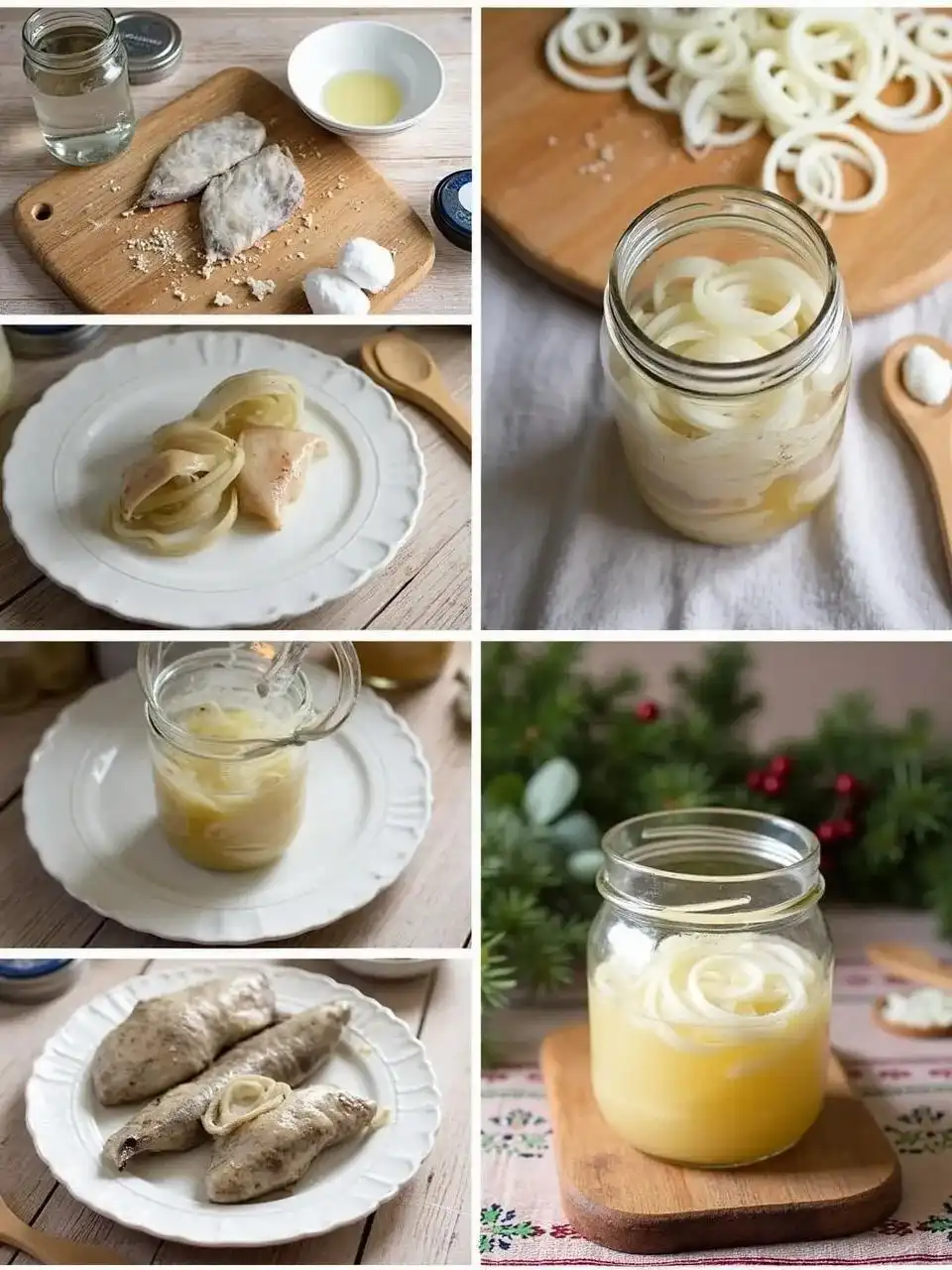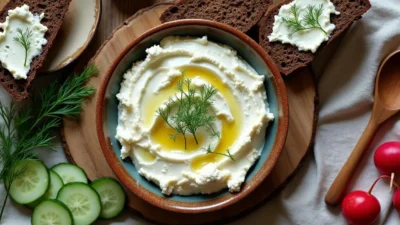Contents
A festive and tangy Lithuanian Christmas Eve dish made with brined herring, onions, and a simple pickling brine. Serve as elegant rollmops or bite-sized pieces alongside rye bread and boiled potatoes for an authentic Kūčios celebration.
Equipment
- Large glass jar with lid
- Mixing bowl
- Measuring cups and spoons
- Sharp knife and cutting board
- Toothpicks or cocktail sticks (for rollmops style)
Ingredients
- 300 g (4 half fillets) herring fillets in brine (not oil)
- 450 ml (2 cups) cold water
- 4-5 small onions (approx. 250g / 8 oz), thinly sliced into rings
- 120 ml (½ cup) apple cider vinegar (or 5–6% white vinegar)
- 40 g (¼ cup) granulated sugar
- A pinch of salt
- A pinch of ground black pepper (or a few whole peppercorns)
Instructions
- If the herring fillets have skin, gently remove it. Dab fillets with paper towels to remove excess brine. Rinse briefly under cold water if they’re very salty.
- In a clean glass jar, layer the herring fillets with thinly sliced onion rings.
- In a separate bowl, mix the cold water, vinegar, sugar, salt, and pepper. Stir until the sugar dissolves.
- Pour the brine over the herring and onions in the jar, making sure everything is submerged.
- Seal the jar with a lid and refrigerate for 6–8 hours or overnight.
- Choose your serving style: - Rollmops: Roll each fillet into a spiral, secure with a cocktail stick, and garnish with onion rings. - Bite-sized: Cut fillets into smaller pieces and serve topped with pickled onions.
- Serve with warm boiled potatoes or slices of dark rye bread.
Notes
 Looking for a showstopping traditional dish to bring authentic Eastern European flavor to your holiday table? These Lithuanian Pickled Herring Rollmops are a timeless centerpiece for Kūčios—the meatless Christmas Eve dinner celebrated across Lithuania.
Served rolled with onions or sliced into bite-sized pieces, these tangy delights pair beautifully with dark rye bread and boiled potatoes, making them a festive favorite steeped in heritage. Whether you’re exploring your Lithuanian roots or simply love bold, briny flavors, this dish belongs on your Christmas table. 🎁🍴
Looking for a showstopping traditional dish to bring authentic Eastern European flavor to your holiday table? These Lithuanian Pickled Herring Rollmops are a timeless centerpiece for Kūčios—the meatless Christmas Eve dinner celebrated across Lithuania.
Served rolled with onions or sliced into bite-sized pieces, these tangy delights pair beautifully with dark rye bread and boiled potatoes, making them a festive favorite steeped in heritage. Whether you’re exploring your Lithuanian roots or simply love bold, briny flavors, this dish belongs on your Christmas table. 🎁🍴🐟 A Deep-Rooted Lithuanian Love Affair with Herring
In Lithuania, herring isn’t just a dish—it’s a cultural symbol. It’s a cherished part of Lithuanian culinary identity and holds a place of honor at every Kūčios celebration. Traditionally, twelve meatless dishes are served on Christmas Eve to symbolize the twelve apostles. And guess what always makes the list? Herring—prepared in several mouthwatering ways! From vinegar marinades to creamy sauces and vibrant tomato dressings, this humble fish is elevated to holiday royalty. 👑🐠 Why so popular? Herring was historically preserved through pickling due to Lithuania’s northern climate and proximity to the Baltic Sea. Over time, it became not just a practical food but a symbolic one—representing frugality, purity, and gratitude.🎄 The Revival of an Acquired Taste
Let’s be honest: herring isn’t always love at first bite—especially for kids. Many Lithuanians remember being “encouraged” to taste it by determined grandparents. 😅 I was no different! I used to dodge the herring platter entirely as a child. But everything changed when I revisited the tradition as an adult. With fresh ingredients and proper technique, I rediscovered herring’s complexity: salty, sweet, acidic, and deeply satisfying. The flavors reminded me of something you might find in a modern Nordic bistro. Fancy and nostalgic at the same time. 🧡🤔 So, What Are Rollmops?
Rollmops are pickled herring fillets rolled around tangy fillings—usually slices of dill pickle or onion—and secured with toothpicks. Their eye-catching spiral shape and punchy flavor make them a popular appetizer across Central and Eastern Europe. While Rollmops have German origins, Lithuanians embraced them as part of their festive cuisine. You’ll often find homemade or store-bought versions at European delis and Russian or German food markets.🛒 Ingredients You’ll Need
Here’s what you’ll need to prepare authentic Lithuanian-style Pickled Herring Rollmops:- 🐟 300g herring fillets in brine (not oil!)
- 💧 450ml cold water
- 🧅 4-5 small onions (approx. 250g), thinly sliced into rings
- 🍎 120ml apple cider vinegar (or any 5–6% mild vinegar)
- 🍬 40g granulated sugar
- 🧂 A pinch of salt and black pepper
- 🌿 Optional: bay leaf, mustard seeds, or whole peppercorns
Tip: Always use herring in brine for best texture—oil-packed herring won’t work well for this recipe.
👩🍳 Step-by-Step Instructions
1. Prep the Herring
If your fillets have skin, gently peel it off. Pat them dry with paper towels and rinse briefly if overly salty.2. Layer the Jar
Place herring fillets and onion rings alternately in a clean, sealable glass jar.3. Make the Pickling Brine
In a bowl, mix the water, vinegar, sugar, salt, and pepper. Stir until the sugar fully dissolves.4. Pour & Pickle
Pour the brine over the herring and onions, ensuring everything is submerged. Seal the jar tightly.5. Chill
Refrigerate for at least 6–8 hours (or overnight) to let the flavors mingle.🍽️ How to Serve Pickled Herring
There are two main ways to enjoy this dish:🌀 Rollmops Style
Roll each herring fillet into a spiral, secure with a cocktail stick, and serve with onion rings from the jar.🔪 Bite-Sized Pieces
Slice the fillets into chunks, top with pickled onions, and serve on a chilled platter. Pair your herring with:- Boiled potatoes with fresh dill 🥔🌿
- Thick slices of dark Lithuanian rye bread 🍞
- A chilled shot of herbal Lithuanian krupnikas (optional 😉)
Pro Tip: Serve with beetroot and potato salad for the ultimate Eastern European feast.
🧊 Storage & Leftovers
Pickled herring actually improves in flavor after a day or two! Store leftovers in an airtight container in the fridge for up to 1 week. It’s the perfect make-ahead dish, and any leftovers make a fabulous post-holiday breakfast.💡 Variations to Try
Feel free to experiment with:- 🟡 Mustard seeds
- 🍃 Bay leaf
- 🧄 A clove of garlic
- 🌶️ Chili flakes (for a little heat!)





Wow, these Lithuanian Pickled Herring Rollmops sound amazing! That Kūčios recipe looks authentic and definitely festive. I love the idea of serving them as both rollmops and bite-sized pieces – such a nice presentation. Adding rye bread and boiled potatoes is the perfect touch. I’m definitely adding this to my holiday cooking list!